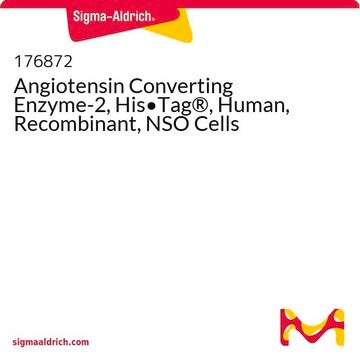SAE0171
Angiotensin Converting Enzyme-2, ACE2
biotin-tagged, human recombinant, ≥1000000U/mg, expressed in HEK 293 cells
Synonym(e):
ACE-related carboxypeptidase, ACE2, Angiotensin-converting enzyme homolog (ACEH), COVID-19 receptor, Metalloprotease MPROT15, SARS-COV2 receptor
About This Item
Empfohlene Produkte
Rekombinant
expressed in HEK 293 cells
Qualitätsniveau
Beschreibung
Biotinylation: ≥90% (gel shift assay)
Assay
≥95% (SDS-PAGE)
Spezifische Aktivität
≥1000000 U/mg
Versandbedingung
wet ice
Lagertemp.
−20°C
Allgemeine Beschreibung
Coronaviruses such as SARS-CoV-2 and SARS-CoV-1 use the host ACE2 as a co-receptor to gain intracellular entry into the lungs and brain. The virion expresses a protein termed spike, which directly binds to the extracellular domain of ACE2. A specific region in the spike protein serves as the receptor binding domain (RBD). The ACE2:spike interaction has a high affinity of 15 nM.
Recombinant human ACE2 is expressed in human HEK 293 cells as a glycoprotein with a C-terminal FLAG® tag and his-tag with a calculated molecular mass of 85.9 kDa. The DTT-reduced protein migrates as a 90–120 kDa polypeptide on SDS-PAGE due to glycosylation.
This ACE2 is labelled with biotin, to form Angiotensin Converting Enzyme-2. This ACE2 biotin-tagged may serve as a useful tool for binding experiments while detecting protein: protein interaction assays using binding partners such as CoV spike protein. The degree of biotinylation is ≥90%. This ACE2-biotin can be visualized with streptavidin-conjugated probes (e.g., Streptavidin, HRP conjugate catalog No. 18-152).
Anwendung
- Exploration of the protein protein interaction of ACE2 with is partners, like COV Spike protein.
- Tool for screening inhibitors for the interaction of ACE2 with COV Spike protein
Biochem./physiol. Wirkung
ACE2 is a new component of the renin-angiotensin system (RAS). It provides protective effects in peripheral tissues and has great potential for the treatment of RAS-related diseases.
Coronaviruses such as SARS-CoV-2 and SARS-CoV-1 use the host ACE2 as a coreceptor to gain intracellular entry into the lungs and brain. The virion expresses a protein termed spike, which directly binds to the extracellular domain of ACE2. A specific region in the spike protein serves as the receptor binding domain (RBD). The ACE2:spike interaction has a high affinity of 15 nM.
Leistungsmerkmale und Vorteile
Einheitendefinition
Sonstige Hinweise
Rechtliche Hinweise
Lagerklassenschlüssel
11 - Combustible Solids
WGK
WGK 2
Analysenzertifikate (COA)
Suchen Sie nach Analysenzertifikate (COA), indem Sie die Lot-/Chargennummer des Produkts eingeben. Lot- und Chargennummern sind auf dem Produktetikett hinter den Wörtern ‘Lot’ oder ‘Batch’ (Lot oder Charge) zu finden.
Besitzen Sie dieses Produkt bereits?
In der Dokumentenbibliothek finden Sie die Dokumentation zu den Produkten, die Sie kürzlich erworben haben.
Unser Team von Wissenschaftlern verfügt über Erfahrung in allen Forschungsbereichen einschließlich Life Science, Materialwissenschaften, chemischer Synthese, Chromatographie, Analytik und vielen mehr..
Setzen Sie sich mit dem technischen Dienst in Verbindung.








